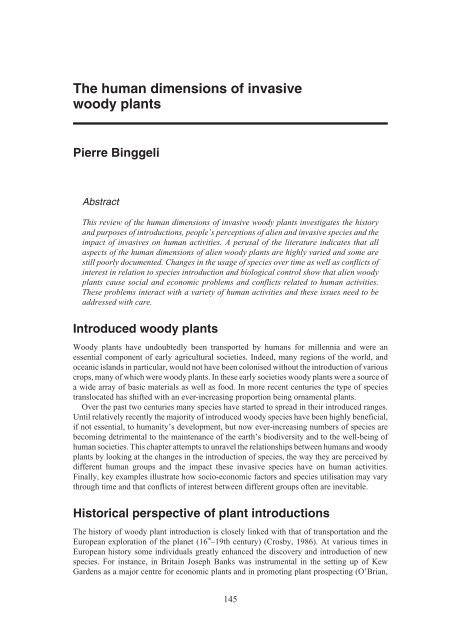Alien Species.vp - IUCN
Alien Species.vp - IUCN
Alien Species.vp - IUCN
You also want an ePaper? Increase the reach of your titles
YUMPU automatically turns print PDFs into web optimized ePapers that Google loves.
The human dimensions of invasive<br />
woody plants<br />
Pierre Binggeli<br />
Abstract<br />
This review of the human dimensions of invasive woody plants investigates the history<br />
and purposes of introductions, people’s perceptions of alien and invasive species and the<br />
impact of invasives on human activities. A perusal of the literature indicates that all<br />
aspects of the human dimensions of alien woody plants are highly varied and some are<br />
still poorly documented. Changes in the usage of species over time as well as conflicts of<br />
interest in relation to species introduction and biological control show that alien woody<br />
plants cause social and economic problems and conflicts related to human activities.<br />
These problems interact with a variety of human activities and these issues need to be<br />
addressed with care.<br />
Introduced woody plants<br />
Woody plants have undoubtedly been transported by humans for millennia and were an<br />
essential component of early agricultural societies. Indeed, many regions of the world, and<br />
oceanic islands in particular, would not have been colonised without the introduction of various<br />
crops, many of which were woody plants. In these early societies woody plants were a source of<br />
a wide array of basic materials as well as food. In more recent centuries the type of species<br />
translocated has shifted with an ever-increasing proportion being ornamental plants.<br />
Over the past two centuries many species have started to spread in their introduced ranges.<br />
Until relatively recently the majority of introduced woody species have been highly beneficial,<br />
if not essential, to humanity’s development, but now ever-increasing numbers of species are<br />
becoming detrimental to the maintenance of the earth’s biodiversity and to the well-being of<br />
human societies. This chapter attempts to unravel the relationships between humans and woody<br />
plants by looking at the changes in the introduction of species, the way they are perceived by<br />
different human groups and the impact these invasive species have on human activities.<br />
Finally, key examples illustrate how socio-economic factors and species utilisation may vary<br />
through time and that conflicts of interest between different groups often are inevitable.<br />
Historical perspective of plant introductions<br />
The history of woody plant introduction is closely linked with that of transportation and the<br />
European exploration of the planet (16 th<br />
–19th century) (Crosby, 1986). At various times in<br />
European history some individuals greatly enhanced the discovery and introduction of new<br />
species. For instance, in Britain Joseph Banks was instrumental in the setting up of Kew<br />
Gardens as a major centre for economic plants and in promoting plant prospecting (O’Brian,<br />
145












